For centuries, Europe was their sandbox. They decided about the fate of nations and dynasty. No other family had such a cynical and deliberate policy. But the Habsburgs did not always shake the continent. And their family origins can really surprise ...
Diligent genealogists have tried for centuries to prove that the Habsburgs were predestined by their origins to rule over the world. Some even claimed that Julius Caesar himself was the ancestor of the dynasty!
Others saw them as descendants of the Pierleoni, Counts of Aventine. When it turned out that the family was of Jewish origin, this thesis was suddenly abandoned. Later the Habsburgs descended from the Carolingians and Merovingians, and through them from the ancient rulers of Troy!
(G) House of the hawks
The oldest known representative of the family is Guntram the Rich, Earl of Alsace who lived in the time of Mieszko I. Some scholars identify him with a member of the Old Lotary family of the Etychonids of the same name. This would greatly increase the prestige of the family… except that Guntram Etychonida was the traitor whom Emperor Otto I had stripped of his land. And this did not bring any honor to the family ...
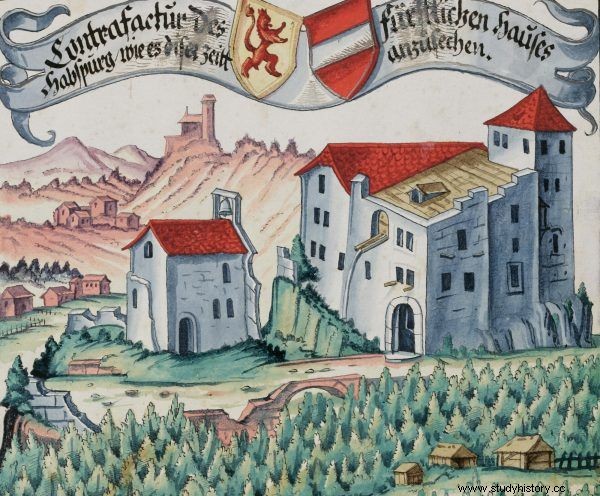
The first realistic representation of the Habsburg castle known to us in an illustration by Hans Ulrich Fisch from 1634 (source:public domain).
Guntram's grandson was Radbot. Together with their brother (or brother-in-law) Werner, the bishop of Strasbourg and a friend of Emperor Henry II, they decided to build a fortress in the center of the family estate in today's northern Switzerland. They named it Hawk Gród - Habitschburg. The name was soon simplified and from 1090 the descendants of Radbot used the surname von Habsburg .
After ages to image The family did not fit the inconspicuous seat, which did not even have decent defensive walls. So the words of rebuke to Radbot were put in Werner's mouth that he did not take care of it. The ancestor of the Habsburgs replied that will build fortifications even in one night . In fact, when Werner got up, walkers were standing around the whole town like a wall, and between them, like towers, were the riders.
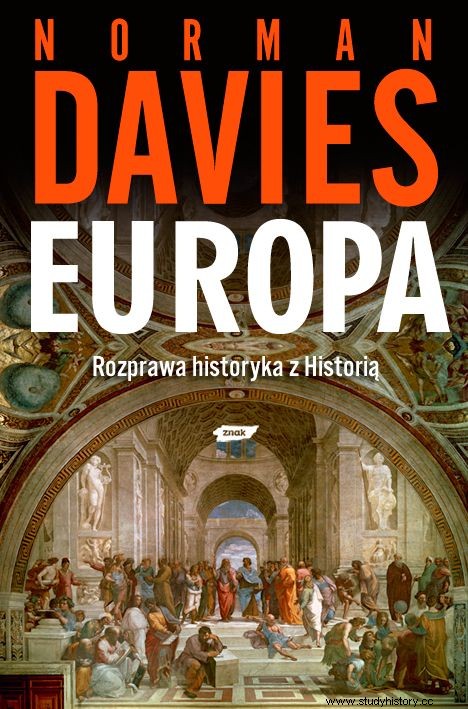
The book by Norman Davies, “Europe. A historian's trial with history ”(Znak 2010).
Riches Pass
Over the next century, the Habsburgs expanded their estates on the border of Switzerland, France and Germany, built castles, towns and monasteries. They controlled the communication routes in the Alps , including the Pass of St. Gotthard. It was they who strengthened its importance by opening a bridge on it. So they became very wealthy. Not only did their subjects get richer on trade and production, but also the toll provided a constant source of income .
The wealthy lords controlling the strategic link between Germany and Italy became the focus of the emperors. The more so because in 1212 the Count of Habsburg was able to collect more money for the monarch than the most powerful lords of the Reich . Emperor Frederick II responded by keeping Rudolf Habsburg born in 1218 for baptism.
Count who became king
Rudolf's reign in the county fell after the death of his godfather, when the Reich plunged into the Great Interregnum. Under these conditions, Rudolf showed himself as a ruthless fighter who was feared by everyone in the area. He took a large part of his property from other members of the family by force . In the fight against the Bishop of Basel, he did not hesitate to attack the city at night and burn down the monastery, for which he was (temporarily) excommunicated by the Pope.
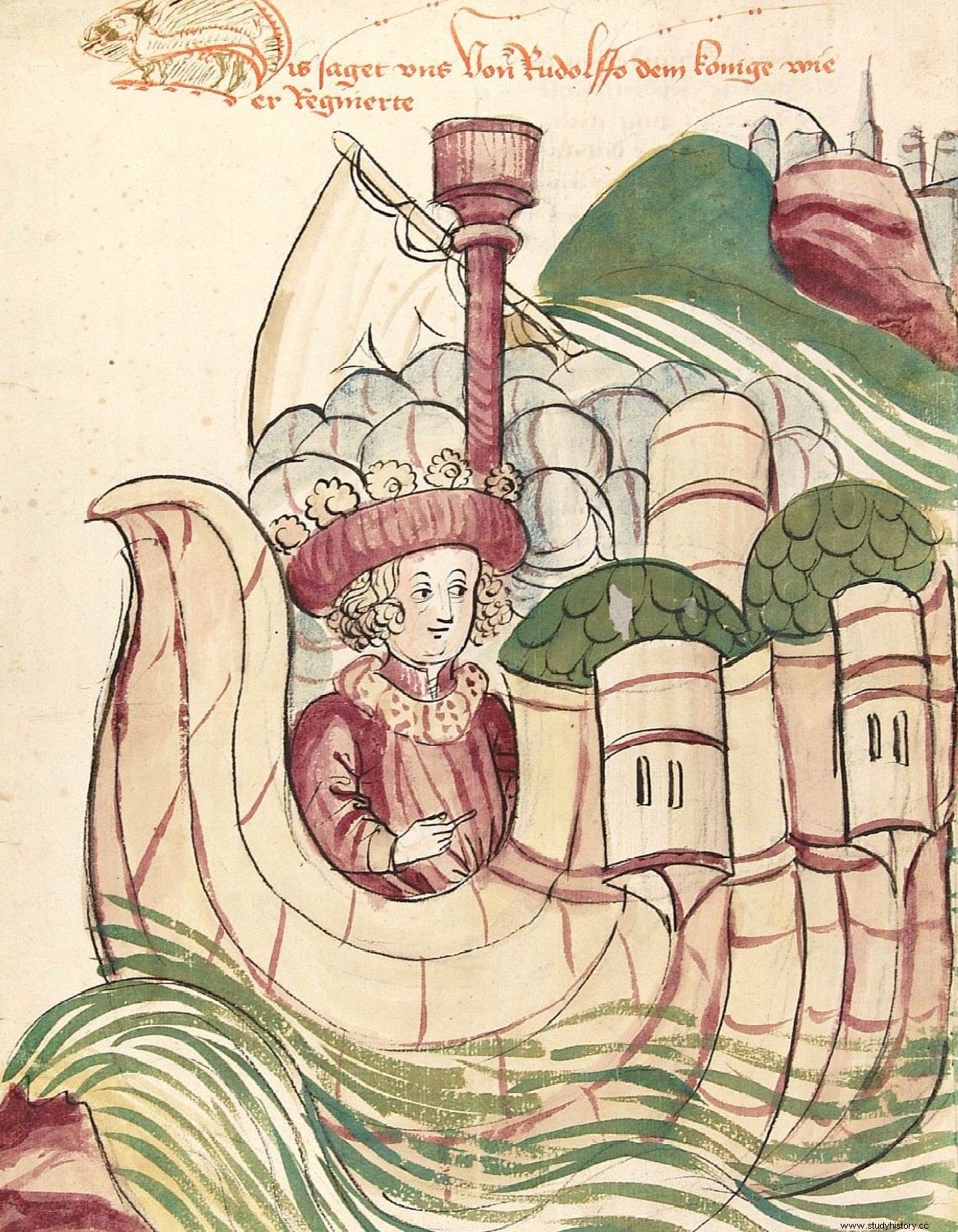
Rudolf Habsburg was the godson of Emperor Frederick II Hohenstaufen. Few, however, expected him to follow in the footsteps of his godfather (source:public domain).
When the German electors gathered to elect a ruler in 1273, powerful families checked each other, not allowing a competitor to be elevated. It was therefore decided to choose someone who would not pose a threat .
The Archbishop of Mainz and the Count of the Palatinate lobbied for Rudolf of Habsburg. The electors picked up on this candidacy. The 55-year-old Rudolf did not have sufficient land footing to oppose the great feudal lords, and the "old" age seemed to guarantee that the reign would be episodic .
Fighting the Industry
The electors had conflicting desires. They wanted a ruler weaker than themselves, but strong enough to introduce new laws and regain the lands appropriated during the interregnum.
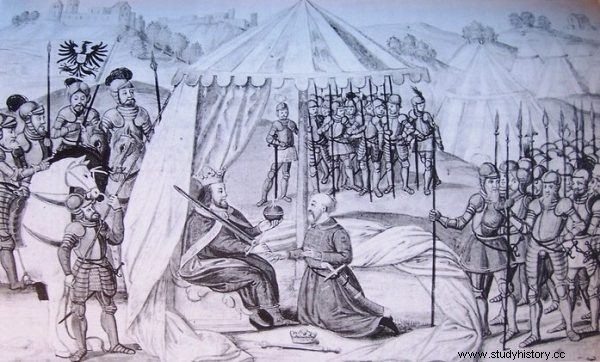
Industry Ottokar II had to finally recognize the superiority of the "poor count" and pay tribute to him in the outskirts of Vienna (source:public domain).
The most important of them was Austria, the heritage of the Babenbergs who died out in 1246. The Czech king Přemysl Otakar seized her. Not agreeing with the results of the election, Ottokar wrote letters to the Curia against what he called "the poor count". Apparently he even ordered a poison for Rudolph from a Styrian witch.
Habsburg issued a war on him. He gained the support of the Pope who even gave him the entire tithing he had collected in Germany. He also convinced the powerful of the Reich to himself by his marriages.
In 1276 he took Austria practically without a fight. Ottokar paid him a feudal tribute at the gates of Vienna . The ceremony was held in a tent, but when Przemyślida was kneeling in front of Rudolf, the walls fell down. The military could see the mighty king at the feet of the "poor count" . Ottokar lost the Babenberg lands. When he tried to recover them two years later, he was defeated and fell at Suchy Kruty.
Habsburg =Austria
Rudolf and his son Albrecht put the situation in Austria in order and reconciled the feudal lords. They extended Vienna's privileges and fostered economic development. In 1282 they received official confirmation of rights to the principality from the Reich Seym.
From then on, Austria became the foundation of the political and material power of the family. The family was even identified with the land - as in the famous motto:"And you, happy Austria, get married". Although the Habsburgs did not have a drop of the blood of previous Austrian rulers in their veins, for centuries they linked their genealogy to theirs, treating the Babenbergs as their own ancestors.
Second Charlemagne
Rudolf took care to ensure safety for his subjects. He was tall, heavily built. He did not like pomp, he ate and drank moderately, he was kind to people. He personified the patriarch and the just judge .
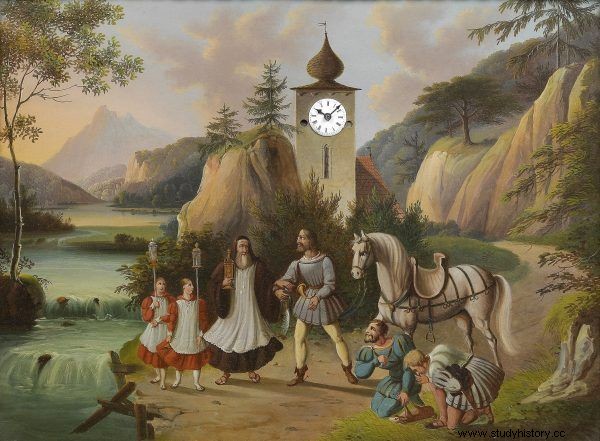
Rudolf Habsburg was the hero of many legends. According to one, he gave his horse to a priest carrying the Blessed Sacrament (19th century illustration from the public domain).
No medieval ruler (except for Charlemagne) was the hero of so many anecdotes and stories. Apparently, after meeting a priest carrying the Holy Sacrament, Rudolf gave him his horse, and when the royal coronation ran out of a scepter, he took the crucifix off the wall and used it.
After almost eighteen years of rule, Rudolph felt his time drawing close and arranged for his burial in the imperial necropolis in Speyer. He failed the more important trick - the coronation of Albrecht's son . For the same reason the electors once chose Rudolph, they now did not want the mighty Duke of Austria to rule.
First attempts at the Czech Republic
Adolf of Nassau became king - less significant at the time of his election than Rudolf. Albrecht conspired against him, and finally led to an armed confrontation at Göllheim, in which killed his opponent "like a deer" . This gave him the throne.
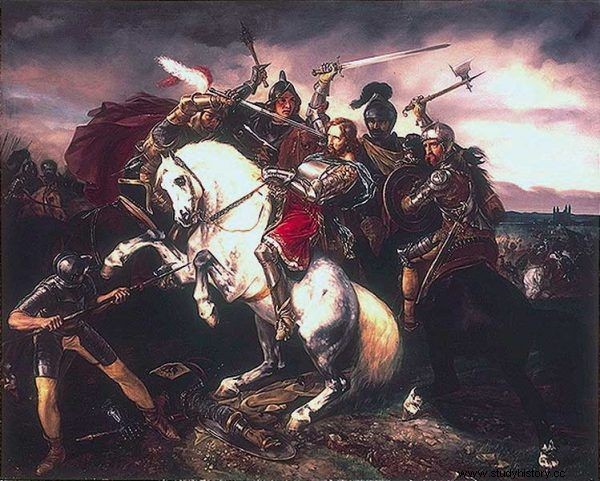
This is how the death of King Adolf of Nassau at the Habsburg hands at the Battle of Göllheim was envisioned by Simon Meister in 1829 (source:public domain).
Albrecht I and his wife fathered twenty-one children. In order not to fragment his fortune, he tried to take over the lands of the extinct counts of the Netherlands. He also tried to put his firstborn Rudolf in Bohemia . He even married him to the widow of Wenceslaus II, Ryksa Elizabeth. And since Ryksa's father was the Polish king, Rudolf became the first Habsburg to claim our crown . However, he died young and the Polish throne slipped out of the Habsburgs' hands.
Meanwhile, John, Albrecht's nephew and nephew of Wenceslaus II, was dissatisfied with the omission of his rights to the Czech throne. On May 1, 1308, he accompanied Albrecht on his journey to the ancestral castle. Just after crossing the river Reuss, Jan murdered his uncle. Albrecht's death shook the family but did nothing to the "parricide" who rotted in prison.
The end of a dynasty?
The Habsburgs lost not only the patriarch of the family. The land from which they had grown out slipped out of their hands too. Already upon the news of the death of Rudolf I the cantons of Szwyz, Uri and Unterwalden joined in an alliance considered to be the beginning of Switzerland . Soon more mountainous areas revolted against the Habsburgs.
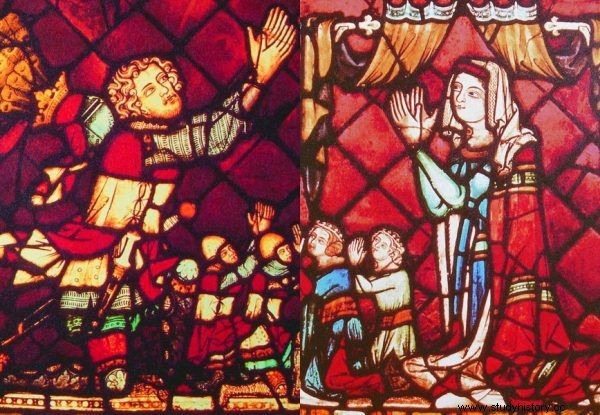
Albrecht II and Joanna von Pfirt. He was lame, she seemed to be sterile. However, without them, the family would die out centuries before its greatest successes (source:public domain).
The legendary archer Wilhelm Tell was sentenced to shoot an apple from his son's head for refusing to bow to the Habsburgs. Their reign was shattered by the lost battles of Morgarten, Laupen and Sempach.
Albrecht I's sons had their father's ambitions, but not his skills . Moreover, they did not have male heirs. The family was on the verge of extinction and was saved by ... the most inconspicuous of Albrecht I's sons.
Reach your destination in a litter
Albrecht II was originally intended for a spiritual career. Due to joint disease, he lost the use of his legs. He could only move in a litter. The crippled ruler gave up the crown and devoted all his efforts to the economic governance of Austria.

The book by Norman Davies, “Europe. A historian's trial with history ”(Znak 2010).
There is an anecdote related to his disability. After talking alone with the King of Bohemia, John of Luxembourg, the gentlemen had a problem to ... leave the room. John was practically blind and Albrecht lame. So the king of Bohemia could not find the handle, and the prince of Austria, although he saw it, could not help him ...
Albrecht II was married to Joanna von Pfirt. For fifteen years their marriage was childless, and her husband's disability seemed to preclude marriage. Meanwhile, the duchess in her forties gave birth to a son, and then five more children. The family was saved, although Albrecht had to confirm his paternity in an official document. Apparently, the successive Habsburgs owed Joanna a characteristic prominent lip.
Pedigree of the Archdukes
The firstborn of Joan and Albrecht, Rudolf IV, the Founder, ordained the indivisibility and co-ownership of the lands and property of the family . This became the basis for the functioning of the House of Habsburg.
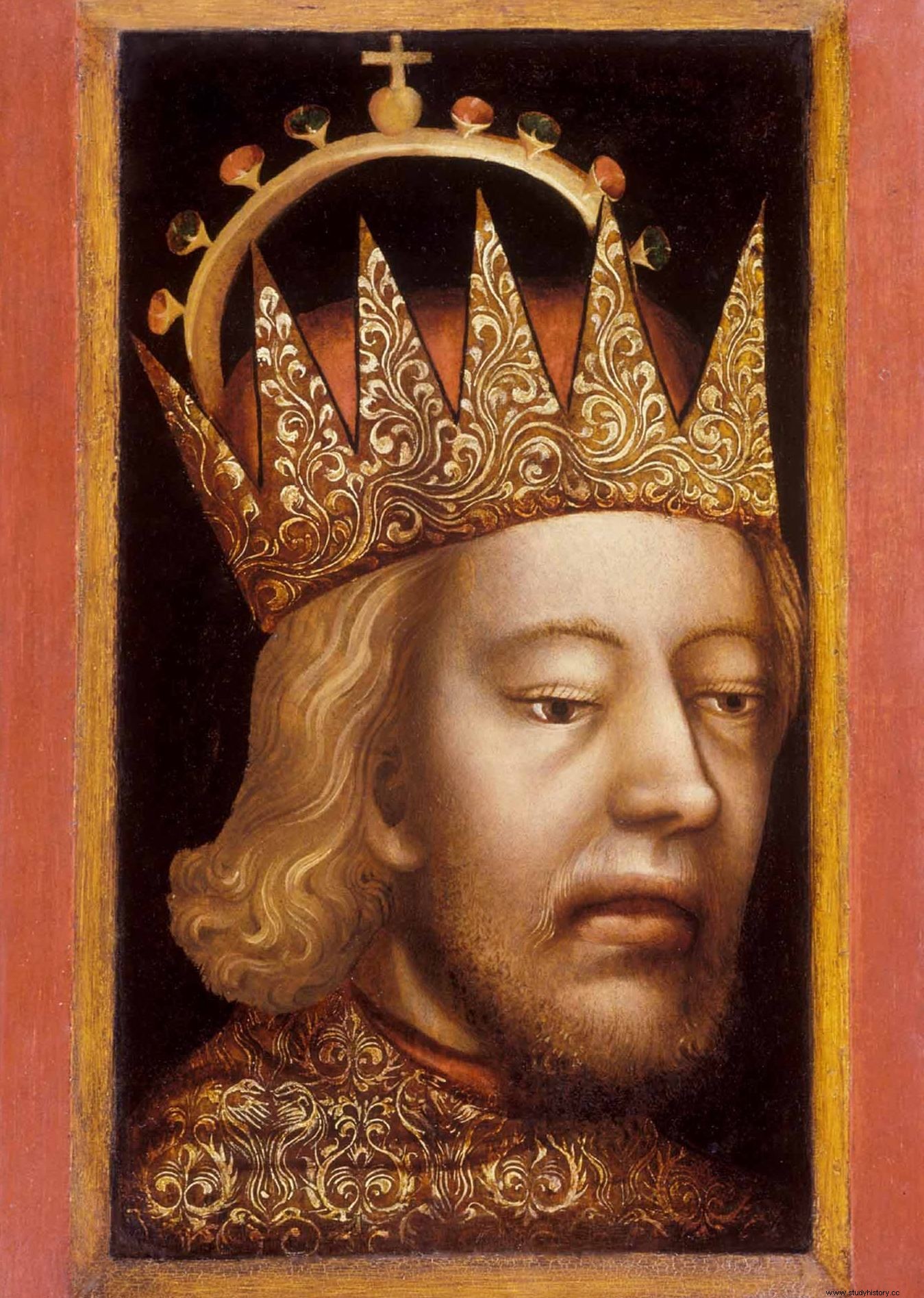
Rudolf IV, the Founder, in one of the oldest independent portraits in European art, depicted wearing an archducal cap. You can see from your face that it is Habsburg ... (source:public domain).
Disappointed that the rulers of Austria were not included among the electors of the Reich, decided to create a different title - Archduke. He even presented the Emperor Charles IV with a fake Privilegium maius . According to her, archducal powers, equal to, if not higher than, electoral ones came from the times of Julius Caesar and Nero.
The emperor did not recognize the document. The Habsburgs, however, behaved as if it was binding. Although it took more than a century to begin the great march for power over the world, their ideology had long been prepared for it ...
